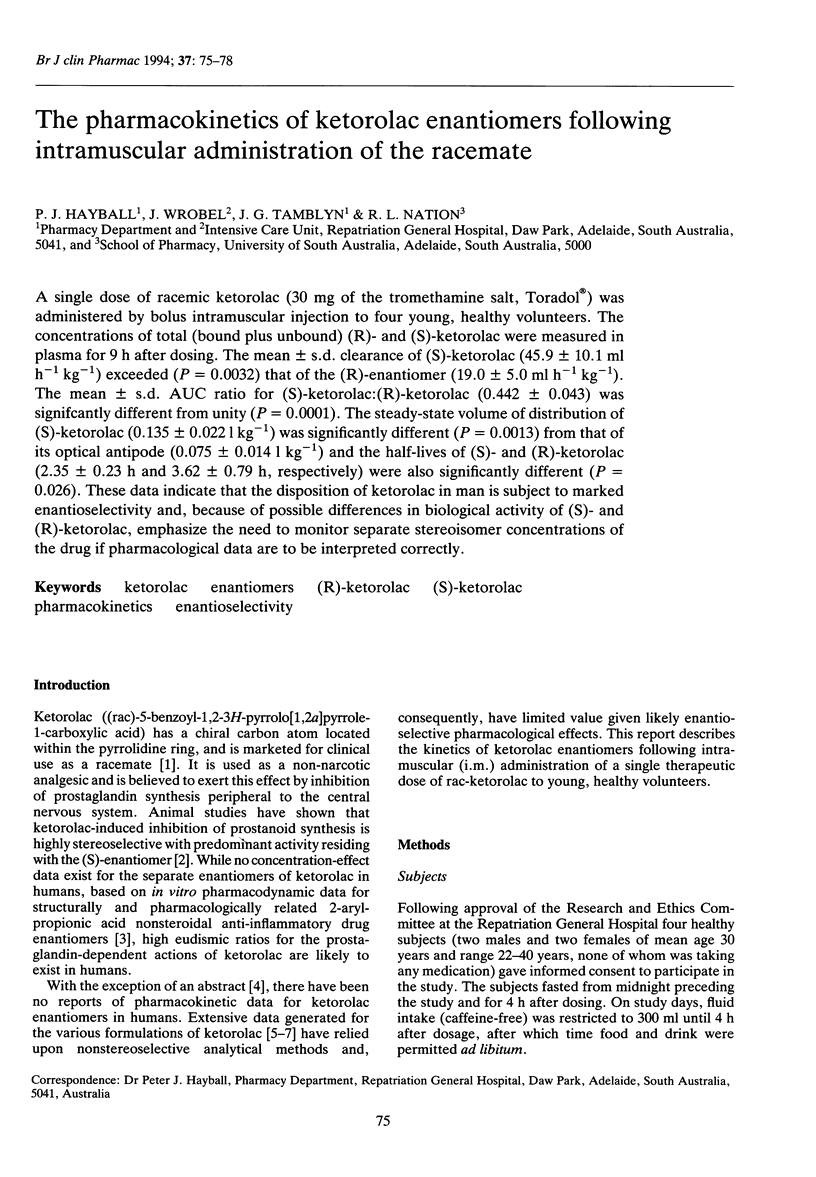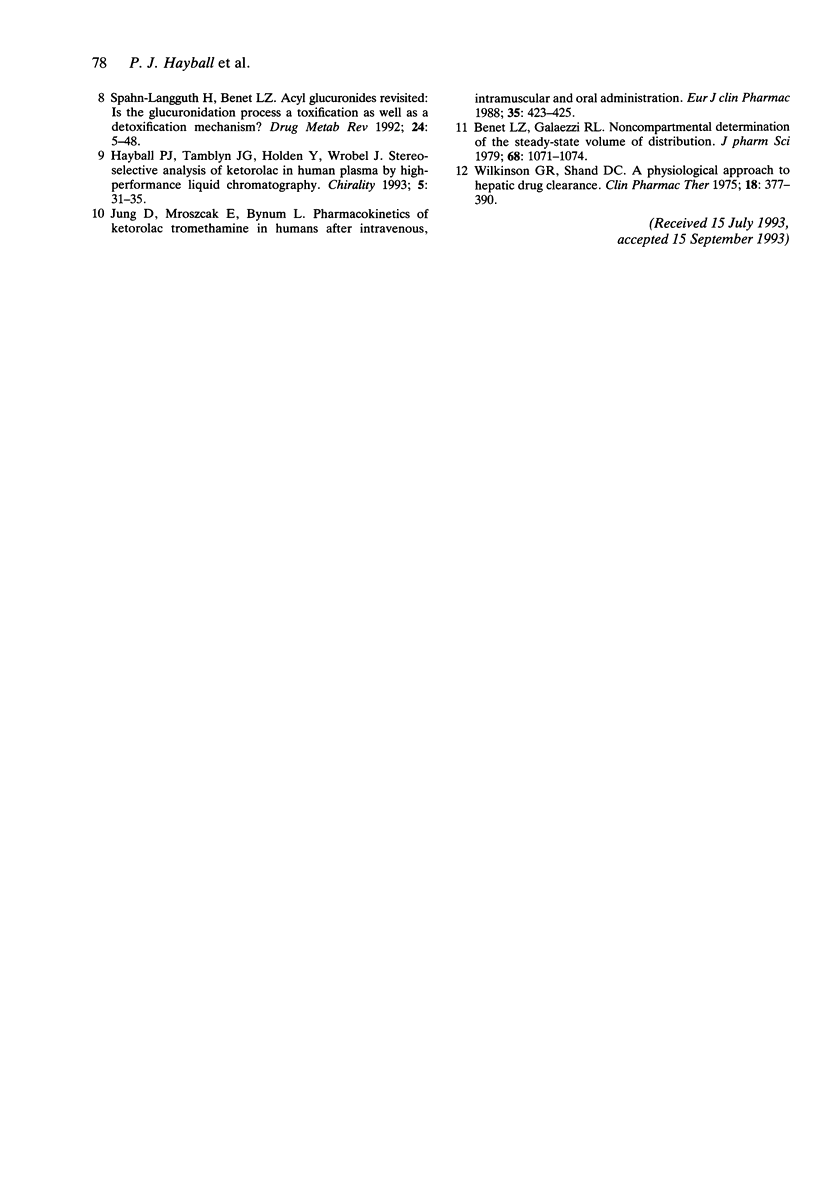Abstract
A single dose of racemic ketorolac (30 mg of tromethamine salt, Toradol) was administered by bolus intramuscular injection to four young, healthy volunteers. The concentrations of total (bound plus unbound) (R)- and (S)-ketorolac were measured in plasma for 9 h after dosing. The mean +/- s.d. clearance of (S)-ketorolac (45.9 +/- 10.1 ml h-1 kg-1) exceeded (P = 0.0032) that of the (R)-enantiomer (19.0 +/- 5.0 ml h-1 kg-1). The mean +/- s.d. AUC ratio for (S)-ketorolac:(R)-ketorolac (0.442 +/- 0.043) was significantly different from unity (P = 0.0001). The steady-state volume of distribution of (S)-ketorolac (0.135 +/- 0.022 l kg-1) was significantly different (P = 0.0013) from that of its optical antipode (0.075 +/- 0.014 l kg-1) and the half-lives of (S)- and (R)-ketorolac (2.35 +/- 0.23 h and 3.62 +/- 0.79 h, respectively) were also significantly different (P = 0.026). These data indicate that the disposition of ketorolac in man is subject to marked enantioselectivity and, because of possible differences in biological activity of (S)- and (R)-ketorolac, emphasize the need to monitor separate stereoisomer concentrations of the drug if pharmacological data are to be interpreted correctly.
Full text
PDF



Selected References
These references are in PubMed. This may not be the complete list of references from this article.
- Benet L. Z., Galeazzi R. L. Noncompartmental determination of the steady-state volume of distribution. J Pharm Sci. 1979 Aug;68(8):1071–1074. doi: 10.1002/jps.2600680845. [DOI] [PubMed] [Google Scholar]
- Evans A. M. Enantioselective pharmacodynamics and pharmacokinetics of chiral non-steroidal anti-inflammatory drugs. Eur J Clin Pharmacol. 1992;42(3):237–256. doi: 10.1007/BF00266343. [DOI] [PubMed] [Google Scholar]
- Guzmán A., Yuste F., Toscano R. A., Young J. M., Van Horn A. R., Muchowski J. M. Absolute configuration of (-)-5-benzoyl-1,2-dihydro-3H-pyrrolo[1,2-alpha]pyrrole-1-carboxylic acid, the active enantiomer of ketorolac. J Med Chem. 1986 Apr;29(4):589–591. doi: 10.1021/jm00154a027. [DOI] [PubMed] [Google Scholar]
- Hayball P. J., Tamblyn J. G., Holden Y., Wrobel J. Stereoselective analysis of ketorolac in human plasma by high-performance liquid chromatography. Chirality. 1993;5(1):31–35. doi: 10.1002/chir.530050107. [DOI] [PubMed] [Google Scholar]
- Jallad N. S., Garg D. C., Martinez J. J., Mroszczak E. J., Weidler D. J. Pharmacokinetics of single-dose oral and intramuscular ketorolac tromethamine in the young and elderly. J Clin Pharmacol. 1990 Jan;30(1):76–81. doi: 10.1002/j.1552-4604.1990.tb03442.x. [DOI] [PubMed] [Google Scholar]
- Jung D., Mroszczak E. J., Wu A., Ling T. L., Sevelius H., Bynum L. Pharmacokinetics of ketorolac and p-hydroxyketorolac following oral and intramuscular administration of ketorolac tromethamine. Pharm Res. 1989 Jan;6(1):62–65. doi: 10.1023/a:1015803803650. [DOI] [PubMed] [Google Scholar]
- Jung D., Mroszczak E., Bynum L. Pharmacokinetics of ketorolac tromethamine in humans after intravenous, intramuscular and oral administration. Eur J Clin Pharmacol. 1988;35(4):423–425. doi: 10.1007/BF00561376. [DOI] [PubMed] [Google Scholar]
- Mroszczak E. J., Lee F. W., Combs D., Sarnquist F. H., Huang B. L., Wu A. T., Tokes L. G., Maddox M. L., Cho D. K. Ketorolac tromethamine absorption, distribution, metabolism, excretion, and pharmacokinetics in animals and humans. Drug Metab Dispos. 1987 Sep-Oct;15(5):618–626. [PubMed] [Google Scholar]
- Rooks W. H., 2nd, Tomolonis A. J., Maloney P. J., Wallach M. B., Schuler M. E. The analgesic and anti-inflammatory profile of (+/-)-5-benzoyl-1,2-dihydro-3H-pyrrolo[1,2a]pyrrole-1-carboxylic acid (RS-37619). Agents Actions. 1982 Dec;12(5-6):684–690. doi: 10.1007/BF01965079. [DOI] [PubMed] [Google Scholar]
- Spahn-Langguth H., Benet L. Z. Acyl glucuronides revisited: is the glucuronidation process a toxification as well as a detoxification mechanism? Drug Metab Rev. 1992;24(1):5–47. doi: 10.3109/03602539208996289. [DOI] [PubMed] [Google Scholar]
- Wilkinson G. R., Shand D. G. Commentary: a physiological approach to hepatic drug clearance. Clin Pharmacol Ther. 1975 Oct;18(4):377–390. doi: 10.1002/cpt1975184377. [DOI] [PubMed] [Google Scholar]


